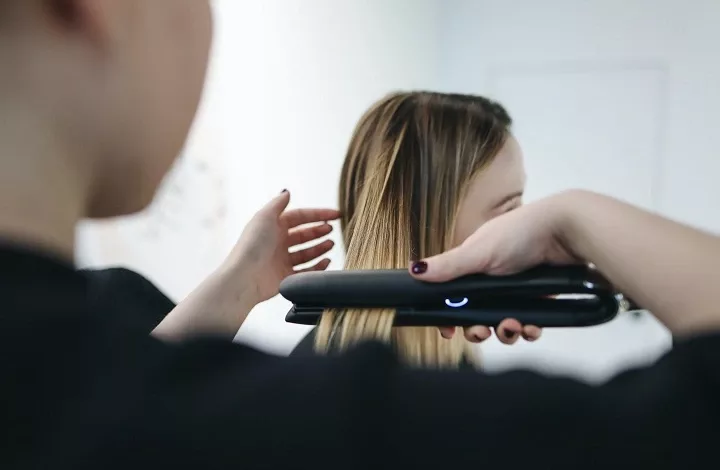Investigating the Adverse Health Effects of Hair Straightening Treatments

For centuries, humans have sought to alter their appearance, and hair texture has been a prime target.
Straight, sleek hair has often been associated with beauty and professionalism, leading many to embrace various hair straightening treatments.
However, beneath the glossy surface of straightened strands lies a potential minefield of adverse health effects that deserve closer examination.
In this article, we explore the intricate link between hair straightening treatments and health, revealing potential hidden costs for aesthetics.
Varieties of Hair Straightening Treatments
The quest for smooth, straight hair has spawned a myriad of hair straightening treatments, each employing distinct methods and formulations. One prevalent approach involves the use of chemical relaxers.
They contain potent ingredients like sodium hydroxide or guanidine hydroxide, which break down the hair’s natural structure to achieve straightness.
Another popular method is thermal straightening, where high temperatures from flat irons or hot combs alter the hair’s bonds temporarily.
Also, the infamous keratin treatments, heralded for their smoothing effects, often contain formaldehyde, a known irritant. Amidst these options, the allure of sleek hair often overshadows the potential consequences.
According to the American Cancer Society, approximately 60% of women who used straighteners in the past year identified as black. This statistic highlights a notable demographic association with the use of hair products.
Also, the widespread adoption of these treatments within specific communities underscores the imperative for comprehensive research and awareness regarding potential health risks.
Health Complaints and Reported Issues
The quest for sleek, straight hair can conceal a myriad of potential health issues, spanning from immediate discomfort to enduring concerns.
Dismissal of these subtle yet significant red flags is unwise, emphasizing the need to scrutinize the trade-offs in pursuing a desired aesthetic.
Prioritizing long-term well-being over immediate beauty gains becomes crucial for making informed and health-conscious choices in personal care practices.
The adverse effects of hair straightening treatments are manifold. Scalp issues, ranging from irritation to allergic reactions, are prevalent with relaxers and keratin treatments.
Both chemical and heat-based methods contribute to hair havoc, causing dryness, breakage, and split ends.
TorHoerman Law states that hair straightener chemicals, like formaldehyde, may be carcinogenic when inhaled or absorbed through the skin, according to studies.
Also, studies have raised concerns about potential links between this treatment and more serious health issues. Frequent use of chemical relaxers may elevate the risk of hormone-related cancers, including breast and uterine cancer, according to NIH research.
A significant number of relaxing treatments, often lye-based, exhibit evidence of causing damage to hair and skin.
ScienceDirect states that a review of 33 articles revealed associations with eczema, skin damage, pain, burns, inflammation, and hair loss.
These treatments have been linked to dermatitis and cicatricial alopecia, involving the destruction of hair follicles.
Investigative Studies and Findings
The allure of straight hair is undeniable, yet the scientific community is uncovering potential health risks associated with straightening methods.
An expanding body of research, driven by anecdotal reports, illuminates the intricate relationship between treatments and health concerns.
Anecdotal reports and personal experiences fuel this exploration, offering insights into the intricate world of hair straightening and its health implications.
One of the most alarming findings comes from the domain of hormone-related cancers. A 2022 study published by the National Cancer Institute found a link between frequent chemical hair straightener use. This association correlated with an increased risk of uterine cancer in black women.
Also, US News reported that research from the Boston University School of Public Health suggests chemical hair straighteners may impact fertility.
This adds to growing evidence of the reproductive health effects of beauty product chemicals.
Similar findings from this study and others sparked widespread concern, triggering a wave of legal actions across the United States.
The hair straightener cancer lawsuit, currently ongoing in the US, highlights the seriousness of these concerns.
Major hair product manufacturers face lawsuits as thousands of women allege that long-term use of chemical relaxers led to uterine cancer.
While the legal battle continues, the underlying science raises critical questions about the safety of these products.
Health Risks Associated with Common Ingredients
The investigation into the adverse health effects of hair straightening focuses on common ingredients prevalent in these products.
Chemical relaxers often feature potent agents like sodium hydroxide linked to scalp irritation and chemical burns.
Formaldehyde, prevalent in some keratin treatments, poses severe respiratory risks and has triggered hair straightener lawsuits.
Even seemingly harmless thermal treatments wield potential dangers, with excessive heat leading to protein degradation and hair fragility.
As consumers increasingly prioritize aesthetics, understanding the health risks associated with these common ingredients becomes paramount.
Exploring these components reveals the intricate interplay between beauty practices and health consequences, advocating for informed hairstyling choices.
Regulatory Measures and Industry Response
Responding to concerns, regulatory bodies are reevaluating and strengthening safety measures within the beauty industry regarding the health effects of hair straightening treatments.
Certain countries enforce stricter regulations on hair care products, particularly focusing on limiting formaldehyde-containing formulations, which are prevalent in many keratin treatments.
Industry watchdogs are increasingly scrutinizing labeling practices, pushing for transparency regarding the potential health risks associated with these products.
However, challenges persist as the regulatory landscape remains fragmented, allowing certain formulations to slip through the cracks.
Industry stakeholders, prompted by consumer demand for safer alternatives, are gradually shifting towards developing and promoting chemical-free, organic options.
Personal Stories and Experiences
In scientific investigations and regulatory discussions on hair straightening’s health effects, personal stories provide a poignant, real-life glimpse into individuals’ experiences.
CNN reported that 32-year-old Missouri resident Jenny Mitchell filed a lawsuit against a hair product manufacturer.
Mitchell alleges that her uterine cancer was directly caused by prolonged exposure to endocrine-disrupting chemicals in the hair care products.
Having used hair relaxers since childhood, Mitchell was diagnosed with cancer at 28. It leads to a full hysterectomy and the heartbreaking loss of her dreams of motherhood.
Also, People reported that Bernadette Gordon, 49, used chemical hair straighteners from 1983 to 2015 and attributed them to her uterine and breast cancer.
The devastating experience led her to undergo a hysterectomy and double mastectomy.
Months of chemotherapy followed, marking the profound impact of her belief in the connection between the hair products and her health issues.
Future Directions and Alternatives
With the discourse on hair straightening’s health effects intensifying, the focus shifts to a future prioritizing aesthetics and individual well-being.
Emerging technologies, such as heat-free styling methods and innovative chemical formulations, present promising alternatives.
Forward-thinking salons are embracing organic and natural products, responding to the growing demand for safer alternatives.
Empowering consumers with knowledge about these alternatives becomes paramount, fostering a cultural shift towards more health-conscious hairstyling choices.
The future of hair care blends innovation, education, and a collective commitment to redefining beauty standards, steering towards safer, sustainable practices.
Navigating the Tangled Strands of Beauty and Health
In the pursuit of sleek, straight locks, the investigation into the adverse health effects of hair straightening treatments solves a complex tapestry.
Glimpsing into the future, an innovative landscape and organic solutions beckon, fostering a harmonious coexistence between beauty and health.
Empowered by knowledge, consumers can reshape the narrative, fostering a culture that celebrates both individual style and well-being.
Untangling the strands, envisioning a future where beauty reflects mindful choices, not merely a reflection in the mirror.





